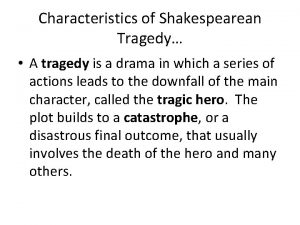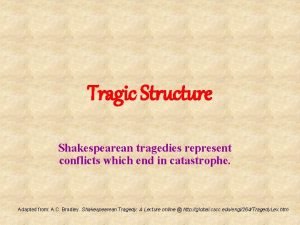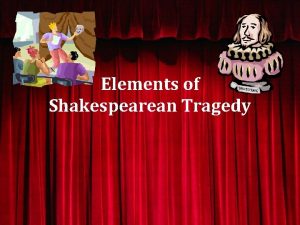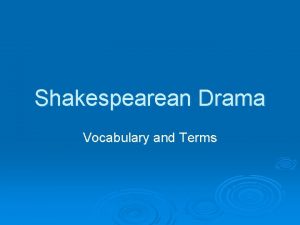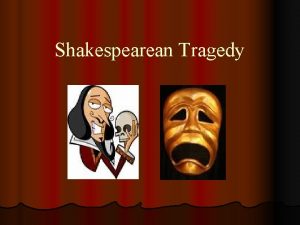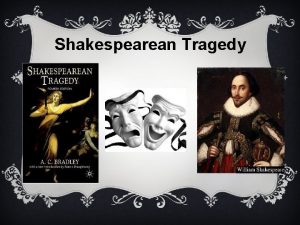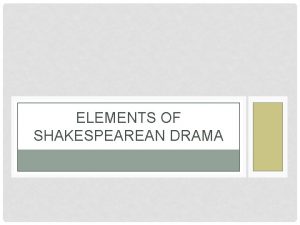SHAKESPEAREAN DRAMA CHARACTERISTICS OF SHAKESPEAREAN TRAGEDY A tragedy











- Slides: 11

SHAKESPEAREAN DRAMA

CHARACTERISTICS OF SHAKESPEAREAN TRAGEDY A tragedy is a drama in which a series of actions lead to the downfall of the main character, called the tragic hero. The plot leads to a catastrophe, or a disastrous final outcome, that usually involves the death of the hero and many others.

TRAGIC HERO Is of high social rank – a king, a prince, a general, etc. Has a tragic flaw – an error in judgment of a character defect – that ultimately leads to his or her downfall. This tragic flaw is usually hubris, excessive pride. Suffers complete ruin or death. Faces his or her downfall with courage and dignity. Usually very relatable, having both good and bad qualities.

DRAMATIC CONVENTIONS: DRAMATIC IRONY Dramatic Irony: Results when the audience knows more than one or more of the characters – for example, Duncan does not know that Macbeth is plotting against him, but the audience does. Helps build suspense.

DRAMATIC CONVENTIONS: SOLILOQUY Soliloquy: a speech given by a character alone on stage, used to reveal his or her private thoughts and feelings. May help the audience understand a character's motivation.

DRAMATIC CONVENTIONS: ASIDE Aside: is a character's remark, either to the audience or to another character, that no one else on stage is supposed to hear. An aside lets the audience in on a character's thoughts or secrets.

THE LANGUAGE OF SHAKESPEARE: BLANK VERSE Shakespeare's plays are verse dramas, in which most of the dialogue is written in the metrical patterns of poetry. Blank verse: unrhymed lines of iambic pentameter. Iambic pentameter: is a pattern of rhythm that has five unstressed syllables, each followed by a stressed syllable. "So foul and fair a day I have not seen. " Most of Macbeth is written in blank verse. In some places, however, Shakespeare broke the pattern to vary the rhythm, create dramatic tension, or distinguish between low-ranking characters of higher rank.

THE LANGUAGE OF SHAKESPEARE: RHETORICAL DEVICES

TIPS FOR READING SHAKESPEARE Study the opening cast of characters, which in Macbeth will tell you the characters' ranks and how they are related to one another. Try to visualize the setting and action by using the information in the stage directions and dialogue. Keep track of the characters, and think about the words and actions reveal about their traits. Pay attention in particular to the actions and motivations of Macbeth and Lady Macbeth. At the end, consider how closely each fits the model of a tragic hero.

TIPS FOR READING SHAKESPEARE (CONT. ) Not examples of foreshadowing, and use each to predict events and better understand the characters' personalities. Use the side notes to understand unfamiliar words and expressions. Remember that the end of a line of does not necessarily mean the end of a thought. Look closely at each line's punctuation, and try to figure out the meaning of the complete sentences or phrases. Paraphrase passages to help you understand characters' public personas as well as their private schemes.

ELIZABETHAN WORDS TO KNOW
 Father of tragedy
Father of tragedy Shakespeare comedy vs tragedy
Shakespeare comedy vs tragedy What are the characteristics of a shakespearean tragedy
What are the characteristics of a shakespearean tragedy Characteristics of a tragedy
Characteristics of a tragedy Tragic structure
Tragic structure Shakespearean comedy vs tragedy
Shakespearean comedy vs tragedy Characteristics of a tragedy
Characteristics of a tragedy Tragedy definition
Tragedy definition Which type of dramatic element is shakespeare using?
Which type of dramatic element is shakespeare using? Shakespearean drama terms
Shakespearean drama terms Short sonnet
Short sonnet Shakespeare's tragic heroes
Shakespeare's tragic heroes



